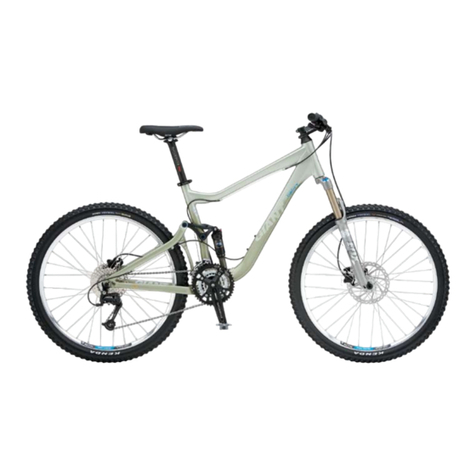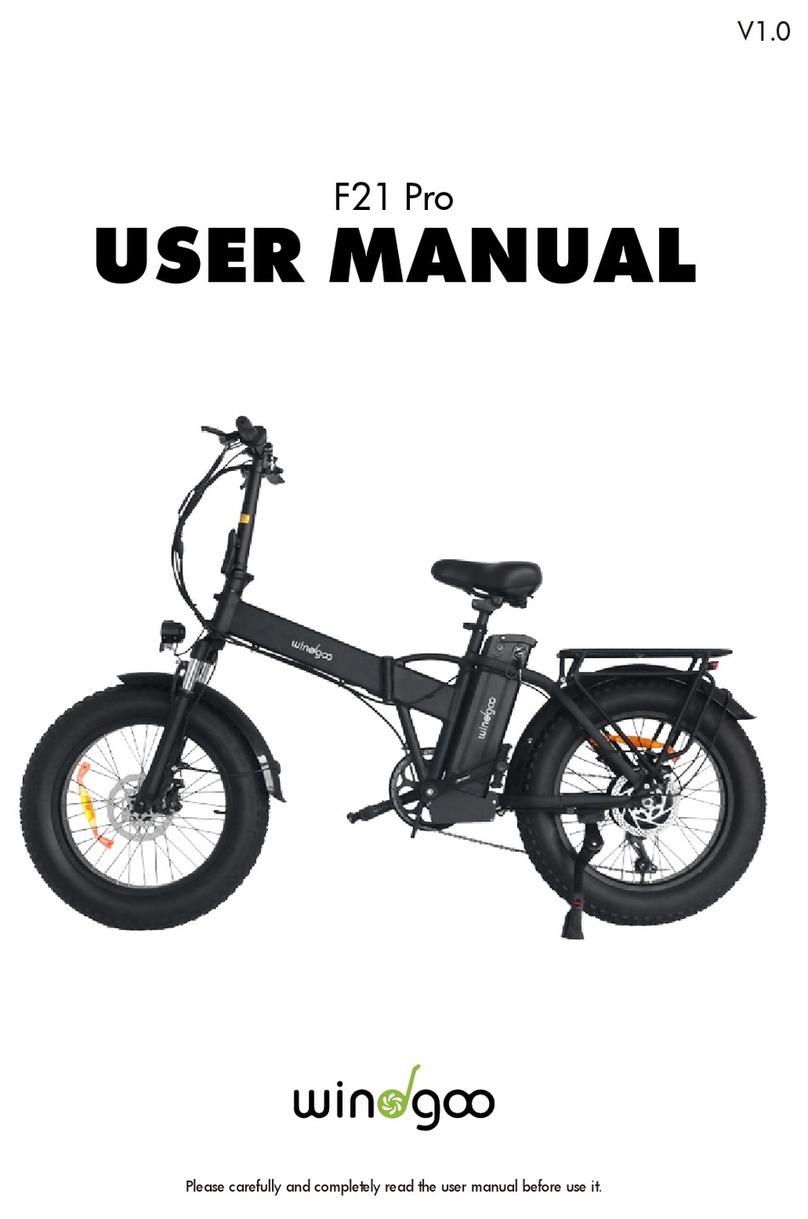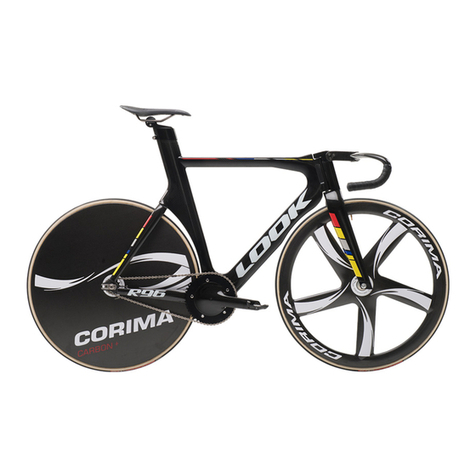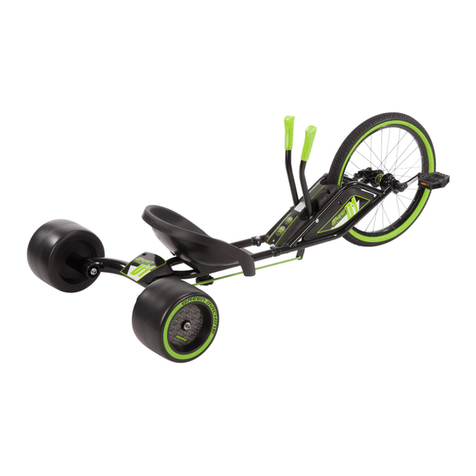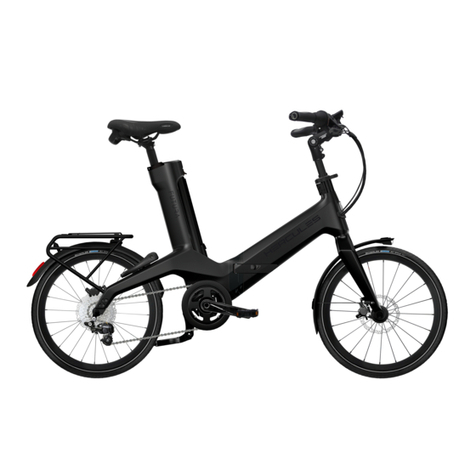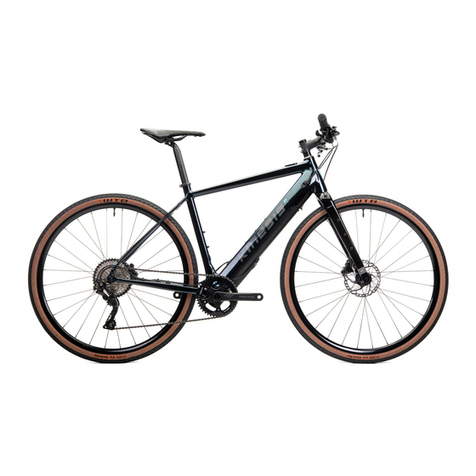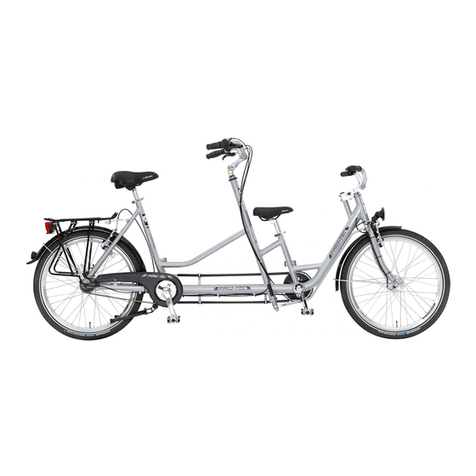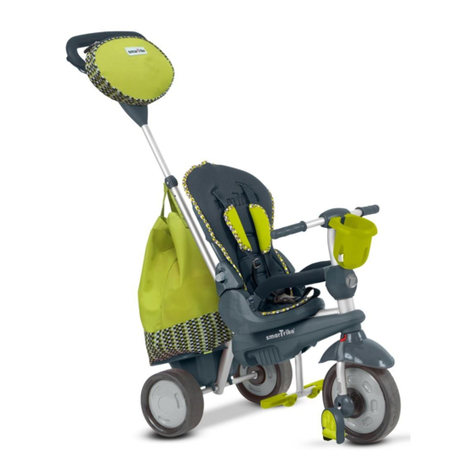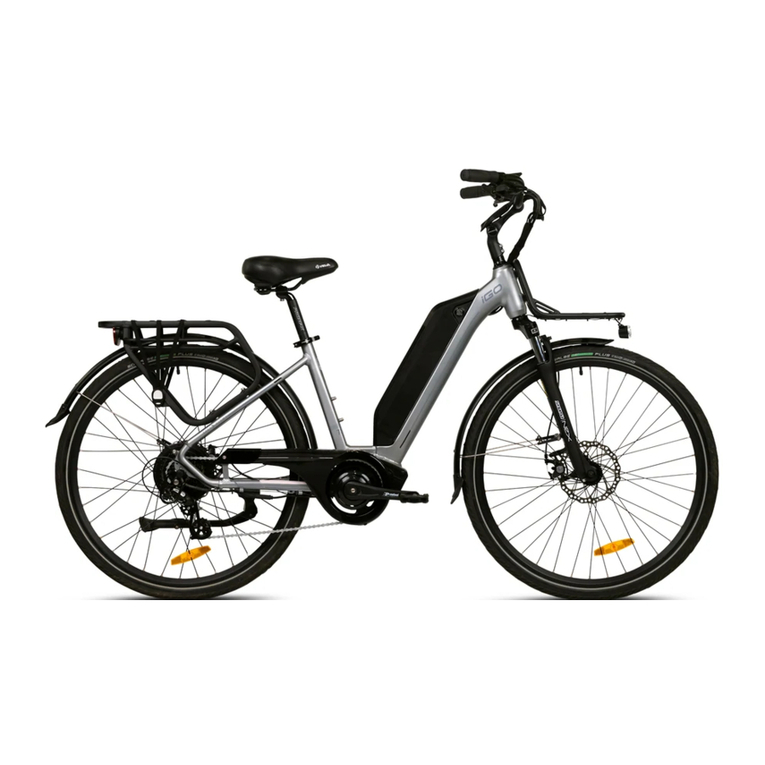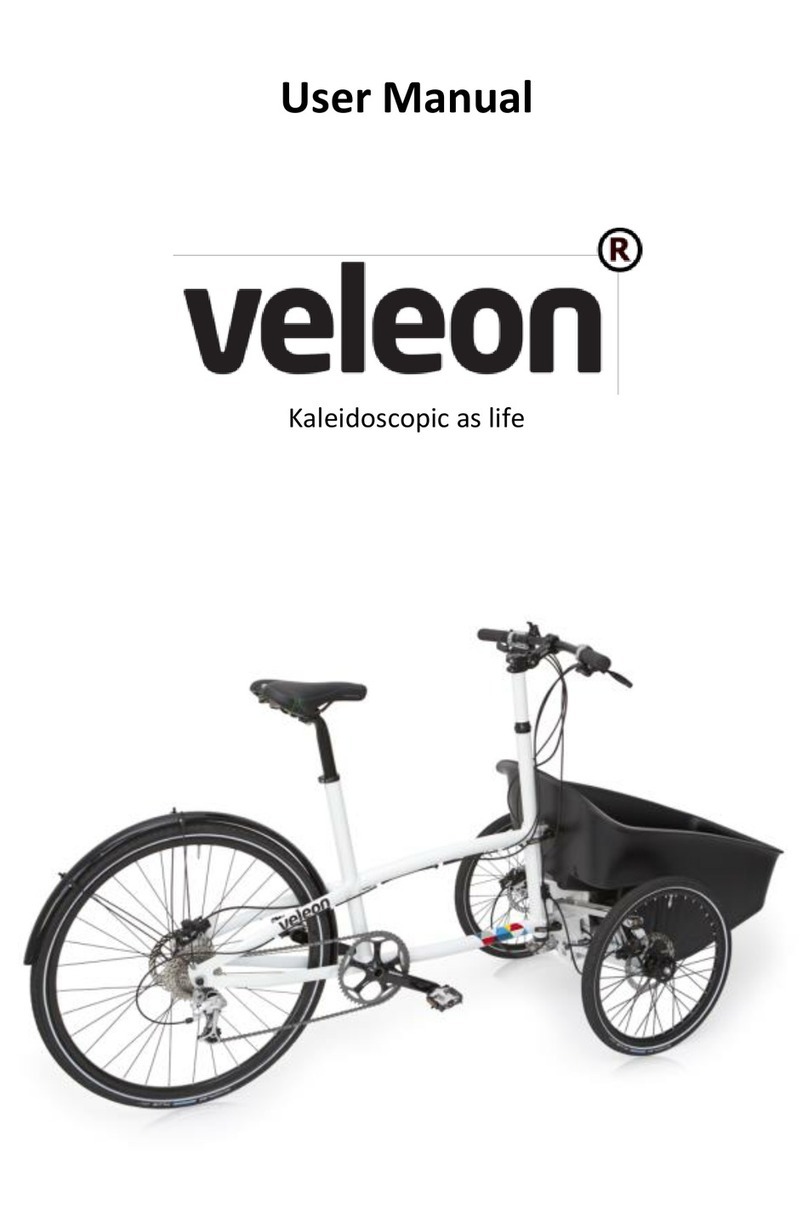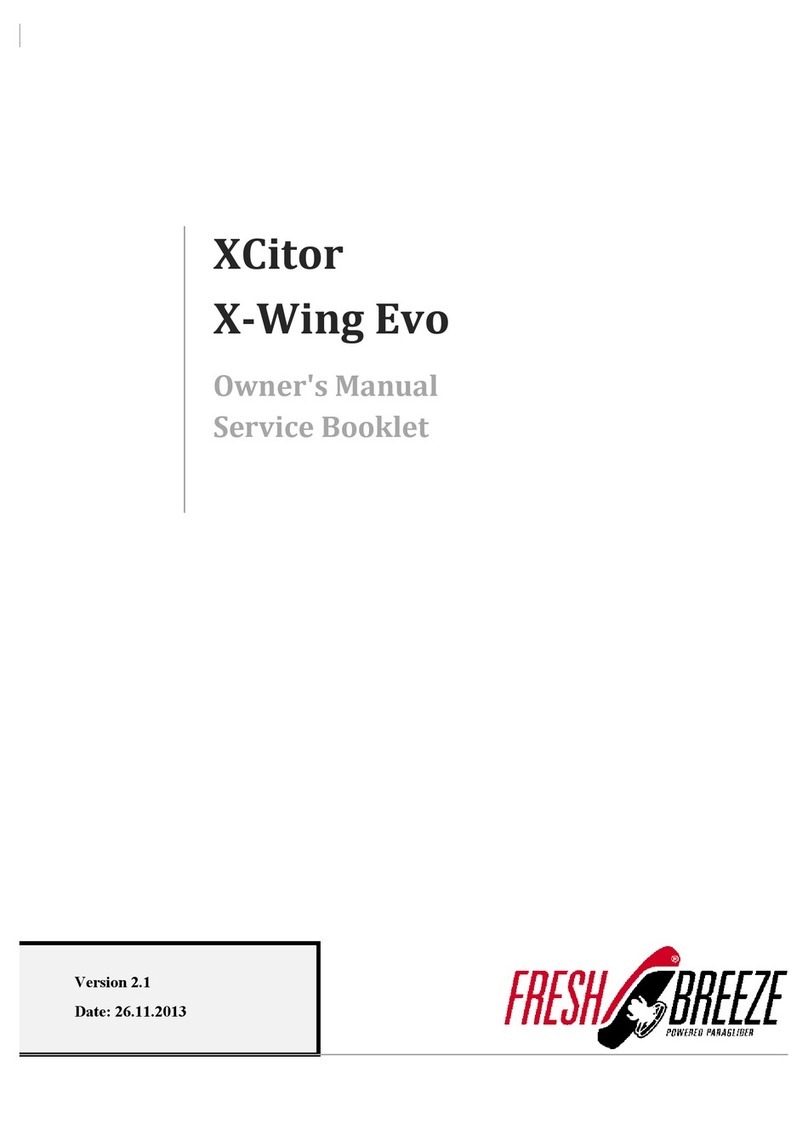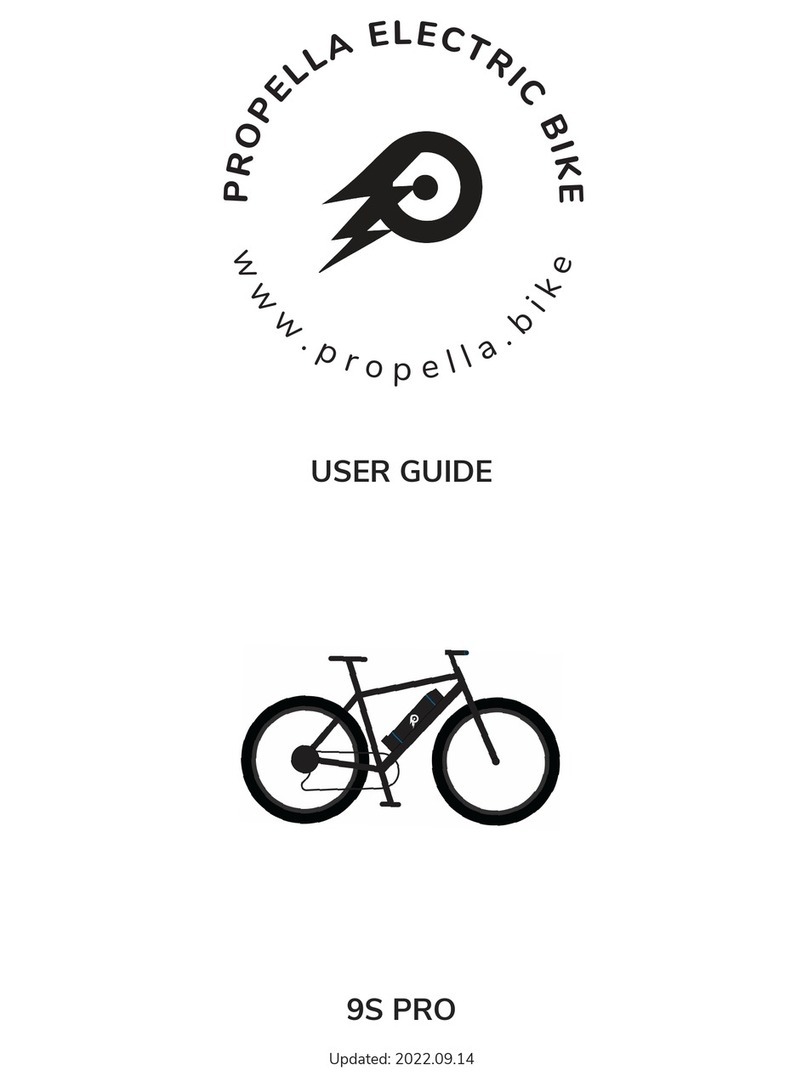Proactive NJ1 e-assistant Parts list manual

NJ1 e-assistant usage instructions
0
Usage instructions
Service booklet
NJ1 e-assistant
Adaptive bike

NJ1 e-assistant usage instructions
1
Contents
1 Preface ............................................................................................................................................... 4
2 Legend ................................................................................................................................................ 4
3 Conformity/other information .............................................................................................................. 4
3.1 Classification ............................................................................................................................... 4
3.2 Conformity................................................................................................................................... 4
3.3 Manufacturer ............................................................................................................................... 4
4 Scope of delivery and testing the product on receipt ......................................................................... 4
5 Introduction ......................................................................................................................................... 5
6 Purpose and indication ....................................................................................................................... 6
7 Proper use .......................................................................................................................................... 6
8 Technical specifications ..................................................................................................................... 7
8.1 Drive system ............................................................................................................................... 7
8.1.1 General instructions ....................................................................................................... 7
8.1.2 Travel range ................................................................................................................... 7
8.1.3 Speed ............................................................................................................................. 7
8.1.4 Maximum permitted speed ............................................................................................ 7
8.2 Climbing power ........................................................................................................................... 7
8.3 Product weight ............................................................................................................................ 8
8.4 Load weight................................................................................................................................. 8
8.5 Obstacle height and turning circle .............................................................................................. 8
8.6 Basic equipment and dimensions ............................................................................................... 8
8.7 Service life .................................................................................................................................. 8
9 Rating plate & markings on the product ............................................................................................. 8
10 Commissioning and handover ............................................................................................................ 9
11 Introduction to the product and the surroundings ............................................................................... 9
12 Safety instructions – prior to driving/use ............................................................................................ 9
13 Safety instructions – while driving/using ......................................................................................... 10
14 Safety instructions regarding obstacles ........................................................................................... 12
15 Safety instructions regarding dangerous locations and dangerous situations ................................. 12
16 Ending the driving operation ............................................................................................................. 13
17 Safety instructions – after driving/use .............................................................................................. 13
18 Adapter and adaptation .................................................................................................................... 13
19 Drive wheel and tyre pressure .......................................................................................................... 13
20 Functional elements ......................................................................................................................... 14
20.1 Parking stand ............................................................................................................................ 14
20.1.1 Active and passive positions ........................................................................................ 14

NJ1 e-assistant usage instructions
2
20.1.2 Parking stand height adjustment ......................................................................... 15
20.2 Bottom bracket support and crank ................................................................................... 16
20.2.1 Seating position ........................................................................................................... 16
20.2.2 Bottom bracket position ............................................................................................... 16
20.2.3 Crank length and grip width ......................................................................................... 18
20.3 Grips ......................................................................................................................................... 18
20.4 Gear shift .................................................................................................................................. 18
20.4.1 Derailleur ...................................................................................................................... 18
20.4.2 Bottom bracket gearshift .............................................................................................. 20
20.5 Brakes ....................................................................................................................................... 20
20.5.1 Disc and rim brakes ..................................................................................................... 21
20.5.2 Parking brake ............................................................................................................... 21
20.5.3 PRO ACTIV back-pedalling brake & crank release function ....................................... 22
20.6 Rechargeable battery pack ....................................................................................................... 23
20.6.1 General instructions ..................................................................................................... 23
20.6.2 Change-over device for double rechargeable batteries .............................................. 23
20.7 Drive system ............................................................................................................................. 24
20.7.1 Switching on and off..................................................................................................... 25
20.7.2 Attaching and removing the display ............................................................................. 25
20.8 Lights ........................................................................................................................................ 26
20.9 Bell ............................................................................................................................................ 27
20.10 Manufacturer instructions ....................................................................................................... 27
21 Storage ............................................................................................................................................. 28
22 Transport .......................................................................................................................................... 28
22.1 Securing handling of the product .............................................................................................. 28
22.2 Passenger transport in vehicles ............................................................................................... 28
22.3 Securing the product in a vehicle (without a person) ............................................................... 28
22.4 Transport in aircrafts ................................................................................................................. 29
23 Malfunctions ..................................................................................................................................... 29
24 Cleaning and care ............................................................................................................................ 29
25 Maintenance ..................................................................................................................................... 30
25.1 General instructions .................................................................................................................. 30
25.2 Service schedules ..................................................................................................................... 30
25.3 Proof of maintenance ................................................................................................................ 31
26 Disposal and recycling ..................................................................................................................... 31
27 Re-use .............................................................................................................................................. 32
28 Warranty ........................................................................................................................................... 32

NJ1 e-assistant usage instructions
3
29 Liability .............................................................................................................................................. 33
30 Appendix: Tightening torques and securing details ......................................................................... 34
31 Appendix: Medical product passport/record of training .................................................................... 35
32 Appendix: Hand-over certificate ....................................................................................................... 36
32.1 Required compliance criteria to authorise use ......................................................................... 36
32.2 Check list for training the user .................................................................................................. 37
33 Appendix: Inspection lists ................................................................................................................. 38
The following instructions are intended for and may only be carried out by the rehabilita-
tion specialist dealer or PRO ACTIV.
This document is available in PDF format at www.proactiv-gmbh.com for visually impaired
people. Using the zoom function, the font can be increased as desired.

NJ1 e-assistant usage instructions
4
1 Preface
Dear Customer,
Congratulations on purchasing your new
PRO ACTIV product. You have bought a quali-
ty product that has been specially customised
to meet your requirements. We have put to-
gether some instructions about its proper and
safe use in the following document. Please
read these instructions before using the
product.
The standard components are explained in
these usage instructions. If you have individual
solutions or non-standard components on your
product, your rehabilitation specialist dealer or
PRO ACTIV would be happy to deal with any
questions you may have about using it.
You can always download the latest version of
the usage instructions as a PDF document in
our download area at www.proactiv-gmbh.com.
If you have any further questions about this or
any of our other products, we would be glad to
be at your disposal.
Enjoy your trips and the best possible mobility.
Your PRO ACTIV team
2 Legend
The symbols used in these usage instructions
have the following meanings:
Manufacturer
Warnings and safety instructions
Serial number
3 Conformity/other information
3.1 Classification
The NJ1 e-assistant (referred to as a "product"
below) is classified as a class I product.
3.2 Conformity
As the manufacturer, PRO ACTIV
Reha-Technik GmbH declares that
the respective product is a class I product and
meets the requirements of the EU Medical
Devices Directive (2017/745).
If the product is adapted in a manner which
has not been agreed by PRO ACTIV Reha-
Technik GmbH, this declaration becomes void.
3.3 Manufacturer
PRO ACTIV Reha-Technik GmbH
Im Hofstätt 11
D-72359 Dotternhausen
Phone +49 7427 9480-0
Fax +49 7427 9480-7025
e-mail: info@proactiv-gmbh.de
web: www.proactiv-gmbh.com
4 Scope of delivery and testing
the product on receipt
The product may only be operated with an
adapter supplied by PRO ACTIV which is suit-
able for the wheelchair.
The scope of delivery includes the product
configured in accordance with the order, re-
chargeable battery/batteries, display/operating
console, mains power charger, usage instruc-
tions including record of training/hand-over
certificate and inspection lists. You can view
the basic equipment in chapter "Technical
specifications". As per your order, the product
is equipped with additional recommended ac-
cessories, such as special handles or
manoeuvring rollers.
Please check that the delivery is complete after
you have received your product.
The product is tested to ensure it is completely
functional before shipping and packed in spe-
cial boxes.

NJ1 e-assistant usage instructions
5
However, please check the product immediate-
ly upon receipt, preferably in the presence of
the freight company, for any damage which
may have occurred in transit. If you are of the
opinion that damage has occurred during
transit, please do the following:
1. Record a statement of facts in the pres-
ence of the freight company - photo docu-
mentation of the packaged product and the
unpacked product with detailed images of
product damage
2. Preparation of a declaration of assignment
- you assign all claims from this damage to
the freight company.
3. Statement of facts/photo documentation,
delivery note, and declaration of assign-
ment are sent to PRO ACTIV.
Failing to observe these instructions, or report-
ing damage after acceptance, means that the
damage cannot be acknowledged.
PRO ACTIV will subsequently review the dam-
age and discuss the further procedure with you
(shipment of replacement parts, returning the
product to PRO ACTIV for a complete repair,
etc.).
5 Introduction
Before starting your first trip, familiarise your-
self with these usage instructions and the us-
age instructions for the coupled wheelchair,
paying particular attention to all the safety in-
formation and hazard warnings they contain.
Allow your therapists and doctors to advise
you, your carers, and assistants on how to use
the product and what you are safe to do with
the product based on your current ability.
Under no circumstances should you do
anything with or in the product which you have
not learnt to do and have not mastered.
You, your carers, and assistants should also
seek advice from your therapists and doctors
as well as the rehabilitation specialist dealer
about the use and settings of your product as
well as all the safety accessories available
(e.g. chest belt and waist-belt).
It is then vital that the advice from doc-
tors, therapists and the rehabilitation specialist
dealer on the necessary safety accessories
should be followed.
If you are not sure how to handle the
product or if technical faults occur, please con-
tact your rehabilitation specialist dealer or
PRO ACTIV before using it.
When operating the product, the wheel-
chair usage instructions must also be ob-
served. Information on limit values must not be
exceeded. If the values in the two sets of us-
age instructions differ, the lower limit is the one
which applies.
The control software is programmed at
the factory to ensure that the legal require-
ments for a pedelec drive are met. If changing
the software, it must be ensured that these
requirements are still met.
Never leave the product unattended, ei-
ther when it is switched on or switched off. If
this cannot be avoided, removing the re-
chargeable battery/batteries and the display
can help prevent unauthorised use.
Secure the product against unauthorised
use and theft.
When combining your product with
equipment made by other manufacturers,
make sure that the individual components and
the unit made up of them still work appropriate-
ly. You can get information on the suitability of
a combination from the manufacturer of the
third-party components or from your rehabilita-
tion specialist retailer.
The product contains small parts that may
pose a choking hazard for children.
The wheelchair with the adapted product
must be equipped in accordance with road
traffic regulations when operated on public
areas, roads paths and spaces.

NJ1 e-assistant usage instructions
6
The product may be used only in conjunc-
tion with the approved adapter. Weight limita-
tions must be observed while doing so. The
Heavy Duty version of the product may be
used only with the Heavy Duty version of the
adapter.
6 Purpose and indication
This product is an electrically-supported, man-
ual adaptive bike that is coupled to a human-
powered wheelchair with the aim of preserving
or increasing the independent mobility of an
active wheelchair user to the greatest extent
possible. The electric drive system supports
the active cranking motion of the arms by the
user, therefore making locomotion easier.
Indications: Walking impediment or limited
ability to walk due to paralysis, limb loss, limb
defect/deformation, joint contractions/joint
damage, neurological and muscular diseases.
Contraindications: Progressive muscle diseas-
es, the course of which is accelerated due to
fatigue of the arm and core muscles used (e.g.
muscle dystrophies and atrophies) and ac-
companying epilepsy disorders (legal stipula-
tions on freedom from seizures for a permit for
use on public roads apply here).
In addition - for safety reasons - the product
may only be operated by people who
can move and coordinate their hands,
arms, and head (when using the chin to
operate the starting aid and the gears if
manual function is unavailable) so that
they can operate all control elements and
conduct full, unrestricted steering move-
ments during the trip.
are physically and mentally capable and
have the visual ability to safely operate the
product in all operating situations and can
meet the legal requirements for use on
public roads. For children or people with
mental, significant motor or visual impair-
ments, the attendants can ensure the re-
quired traffic safety as a substitute and as
a companion.
have been trained in its use by the rehabili-
tation specialist dealer or PRO ACTIV.
7 Proper use
This adaptive bike is designed to be used out-
doors on tarmac and adequately paved roads
that ensure traction and stability of the product
when driving and braking. When used indoors,
there must be enough space for manoeuvring.
Avoid driving in poor weather conditions (e.g.,
storms) since this can lead to incalculable
risks.
The maximum permitted load of the product in
its standard design is 120 kg towed capacity
and 10 kg payload. The heavy-duty version
and individual customisations can be designed
for a higher load; this is then indicated on the
rating plate. Please ensure that the load limit
indicated on the ratings plate is not exceeded
when transporting objects.
Recommended equipment:
The wheelchair should be equipped with a
wheelbase extension; the maximum permissi-
ble load for the wheelbase extension must be
then be observed. Before driving with the trac-
tion system, the wheelchair wheels should then
be positioned in the wheelbase extension. This
allows better distribution of the weight between
the drive wheel of the product and the wheel-
chair wheels to be achieved. This minimises
the risk of the product wheel slipping on
slopes.
Figure 1: Removable wheelbase extension

NJ1 e-assistant usage instructions
7
Recommended equipment:
The wheelchair can be equipped with an anti-
roll back device that can be activated before
driving on slopes. The anti-roll back device can
also be used if a wheelbase extension is used
on the wheelchair.
Figure 2: Anti-roll back device
Proper use of the product is a basic require-
ment of safe operation. The product may gen-
erally be used only for applications that are
listed and described in these usage instruc-
tions. This includes storage, transport, mainte-
nance/inspection, and repair, as well as the
safety information in each chapter of these
usage instructions.
8 Technical specifications
8.1 Drive system
8.1.1 General instructions
The technical specifications, information and
usage instructions about the drive system can
be found in the included usage instructions
from the drive manufacturer.
8.1.2 Travel range
The range of the drive system varies depend-
ing on the travelled terrain, the prevailing driv-
ing conditions, and the user weight. Under
optimal driving conditions (user applying max-
imum force onto the pedal crank, level terrain,
fully charged rechargeable battery/batteries,
new rechargeable battery/batteries, ambient
temperature of 20°C, constant speed, optimal
tyre pressure, no headwind, etc.), and a user
weight of approx. 85 kg, the following ranges
can be achieved:
With a neodrives G2 RR rechargeable battery,
36 V, 14.25 Ah, 513 Wh: approx. 70 km
With a neodrives G3 DT rechargeable battery,
36 V 17 Ah, 612 Wh: approx. 80 km
With double neodrives G2 RR rechargeable
battery, 36 V, 14.25 Ah, 513 Wh:
approx. 140 km
With double neodrives G3 DT rechargeable
battery, 36 V, 17 Ah, 612 Wh: approx. 160 km
8.1.3 Speed
A continuously adjustable speed of up to
6 km/h can be achieved using the pushing
aid or starting aid without moving the crank.
Motor support above this speed is only pro-
vided with manual rotation of the pedal
crank. Motor support is provided up to a maxi-
mum speed of 24.9 km/h.
8.1.4 Maximum permitted speed
With regards to the drive system, a maximum
permitted speed is defined for non-motorised
use and for driving downhill with the drive sys-
tem switched on or off. If this maximum speed
is exceeded, you endanger the electronic
components. In a worst-case scenario, they
may be damaged. The maximum speed is
logged by the system and depends on the
selected drive system and the wheel size:
65 km/h with wheel size of 24”
55 km/h with wheel size of 20”
8.2 Climbing power
The climbing power refers to the ability of the
wheelchair-product combination to climb a
slope. This strongly depends on the weight
distribution between the wheelchair wheels
and the product's drive wheel, the total weight
of the combination, and the friction coefficient
of the ground. Under sub-optimal conditions

NJ1 e-assistant usage instructions
8
(e.g. slippery ground when wet), the drive
wheel may start to spin before the maximum
climbing power has been reached.
Under optimal conditions (optimal tyre pres-
sure, wheelchair wheels in the wheelbase ex-
tension, dry, clean and firm ground, etc.), the
product is capable of climbing the following
slopes with a speed greater than 2 km/h:
10 % or 6°
The slope that can be driven up using the
product-wheelchair combination is dependent
on the manual driving force applied by the user
as well as the maximum climbing power.
8.3 Product weight
The total weight starts from 19.5 kg with the
basic equipment (including one rechargeable
battery).
8.4 Load weight
Maximum load weight:
120 kg towing capacity and 10 kg payload
The heavy-duty version and individual custom-
isations can be designed for a higher load; this
is then indicated on the rating plate. In this
case, an adapter is required for heavier loads.
The Heavy Duty version of the adapter is ap-
proved for 120 kg - 200 kg.
When operating the product, the wheelchair
usage instructions must also be observed.
Information on limit values must not be ex-
ceeded. If the values in the two sets of usage
instructions differ, the lower limit is the one
which applies.
8.5 Obstacle height and turning circle
Maximum drive-over/negotiable obstacle
height: 10 cm (must be ensured through an
appropriate adapter assembly/setting, caster
wheels must be removed ( recommended
equipment of the wheelchair: caster forks with
quick-release axle))
This value can, however, be reduced due to
the specifications of the type of wheelchair or
its settings. Therefore, you should observe the
values given in the wheelchair's usage instruc-
tions or the restrictions dependent on the set-
tings.
Turning circle:
approx. 4 m without manoeuvring back and
forth
approx. 2.6 m with manoeuvring back and
forth (strongly dependent on the number of
manoeuvres)
8.6 Basic equipment and dimensions
In the basic equipment, the product comprises
a drive unit with docking plate, parking stands,
handles with shifting and brake fittings, derail-
leur, rim brake including handbrake locking
mechanism, hydraulic disk brake and drive
system. Furthermore, there is a light set and a
mudguard on the product.
Dimensions, NJ1 e-assistant:
Product height: approx. 75-110 cm (depending
on the wheel size and length of the bottom
bracket support)
Product width: approx. 45-63 cm (depending
on the grip width, parking stand in passive
position)
Grip width: 40 - 58 cm
Crank length: 155 - 195 cm
8.7 Service life
The service life of the product is 6 years.
9 Rating plate & markings on the
product
The rating plate is located on the rechargea-
ble battery holder. The rating plate includes the
precise model, the serial number and other
technical specifications.

NJ1 e-assistant usage instructions
9
When contacting your rehabilitation specialist
dealer or PRO ACTIV with regard to your
product, please always have the serial number
and year of construction on the rating plate at
hand.
CE marking
“European conformity”
Medical device
Manufacturer
Follow the usage instructions
Serial number
Date of manufacture
Electric components must be properly
disposed of at government-designated
recycling facilities
10 Commissioning and handover
The product will be handed over to you ready
for use by a rehabilitation specialist dealer or a
field representative or by a product consultant
from PRO ACTIV. They will fit, if not already
done, the required fastening elements to your
wheelchair to hold the adapter and, if required,
any other accessories. The height of the park-
ing stand is also adjusted correctly.
Finally, you will be fully instructed in the use of
the product based on the usage instructions
included in delivery. You will be handed over a
record of training and handover certificate as
written proof. In addition, you will be handed
the usage instructions and, if necessary, fur-
ther accessories for your own use. It is
recommended that you take along an assistant
to the training so that, if required, they can
assist you later when handling the product.
During the hand-over, the record of training
(chapter 31) and the hand-over certificate in-
cluding the associated check list (chapter 32)
must be filled in. The rehabilitation specialist
dealer should send the completed documents
to PRO ACTIV for filing as a file by e-mail or in
the form of a copy by fax or in the post.
11 Introduction to the product and
the surroundings
During the initial commissioning of the product,
drive at minimum speed and become accus-
tomed to the driving characteristics of the
product. Always adapt the speed and driving
manoeuvres to match your own abilities, the
external circumstances and the legal regula-
tions. You will get a feel for how to use the
product safely after a short time. Before driving
up or down slopes or hills with the product, you
should be proficient in the safe handling of the
product on level ground. Get familiar with the
braking distance at different speeds.
Get to know the environment in which you wish
to use the product. Look out for obstacles and
learn how to overcome or avoid them.
Get familiar with the road traffic regulations,
since these must be observed when driving on
public roads.
12 Safety instructions – prior to
driving/use
If your wheelchair is operated in combina-
tion with the product, any existing anti-tipping
supports must be put into their passive position
or removed (see the wheelchair's usage in-
structions). If the wheelchair is then used with-
out the product, the anti-tipping supports must
be brought back into their operating position
again to ensure tipping stability.

NJ1 e-assistant usage instructions
10
Before every trip, check the condition of
the wheels of the wheelchair-product combina-
tion (e.g. visual inspection of the spokes and
rims, check the tyres for damage, foreign bod-
ies and crack formation). If you have any
doubts, the wheelchair-product combination
must not be operated any further. In this case,
contact your rehabilitation specialist dealer or
PRO ACTIV.
Check the air pressure in the tyres of the
wheelchair-product combination at regular
intervals. Ensure that you comply with the
manufacturer's specifications which can be
found on the tyres. When the tyre pressure is
too low, it has a detrimental effect on the driv-
ing behaviour, the range, and the braking reac-
tion of the product. Moreover, there is an in-
creased risk of a flat tyre.
Before starting your trip, check all electri-
cal plug connections for firm contact and the
rechargeable batteries for firm seating in the
rechargeable battery holders.
Before starting your trip, check the func-
tioning of the product's brake. If all existing
brakes are not fully functional, no trips may be
taken.
Before every trip, check that the product
is firmly attached to the adapter and that the
adapter is firmly attached to the wheelchair.
The product may not be operated on the
wheelchair if any of the connections are not
tight and secure. In this case, contact your
rehabilitation specialist dealer or PRO ACTIV.
Always ensure that your feet cannot slip
off the footplate support of the wheelchair
when using the product.
Depending on the equipment, the product
may have folding/closing mechanisms that
pose a risk of crushing injuries (e.g. pinching
your fingers). For this reason, please allow
your rehabilitation specialist dealer to explain
how to work these mechanisms and then have
a go yourself under instruction.
Check the function of the front and rear
lights as well as the effectiveness of the side
and rear reflectors before every trip. Lights and
reflectors must be clearly visible during the trip
and must not be covered by objects.
It is recommended that you only take a
trip with completely charged rechargeable
batteries. If this recommendation is not fol-
lowed, you must take into account that the
range will be restricted when planning your
route. When driving long distances, it is rec-
ommended to take along a fully charged re-
placement rechargeable battery.
To minimise the risk of suffering serious
head injuries in the event of a fall, a helmet
should always be worn when driving with the
product.
When travelling, always carry a repair kit
and tyre pump for repairs in event of punc-
tured/flat tyre. An alternative to this is an
emergency puncture repair spray that fills your
tyre with a foam that hardens in the tyre.
13 Safety instructions – while
driving/using
The usage instructions of the connected
wheelchair must be strictly observed when
using the product.
Please note that some parts of your prod-
uct can become extremely hot in high ambient
temperatures. This means that above 50°C,
the product may be damaged and above 40°C
there is already the risk of burns for the user,
which should not be underestimated, particu-
larly for people with impaired sensitivity. For
this reason, the product should not be exposed
to such extreme temperatures. PRO ACTIV
cannot accept any liability or provide any war-
ranty for personal injury and material damage
caused by such stresses. Similarly, there are
also certain risks at extremely low tempera-
tures.

NJ1 e-assistant usage instructions
11
Always hold onto the crank handles with
both hands while driving, braking, and
manoeuvring. If a driving situation requires you
to take one hand off the crank handle, make
sure the speed has been reduced to the mini-
mum possible beforehand.
When driving in curves, reduce your
speed to a minimum and if possible, lean your
upper body towards the curve.
Do not ride parallel to slopes and inclina-
tions due to the risk of tipping.
You may only drive on slopes where the
wheelchair-product combination can be safely
controlled by steering and braking of the
product.
Do not stop on a steep slope, otherwise
there is a risk of losing control of the product. If
possible, do not turn on a slope or change your
direction.
Never turn the product off on upwards or
downwards slopes. This could result in dan-
gerous situations to which you can only react
with a delay in terms of electrical assistance or
virtually not at all by manual means.
When the drive system is switched on,
the smallest movement on the crank handle is
converted into a drive command. When waiting
at potential hazard areas (e.g. while waiting at
a pedestrian crossing or at ramps), always
keep the service brakes applied and keep the
crank handles in a vertical position downwards.
In rooms, tight or dangerous areas or
when manoeuvring, the product may only be
used with the drive inactive and turned off to
prevent unintentional drive signals. Due to the
increased turning circle, it can be difficult to
turn in buildings, in front of or in lifts or other
buildings, as the standard in such buildings
assumes a maximum turning circle of 1.5 m.
Do not attach objects (carrier bags, etc.)
to the product. These could cause an unwant-
ed drive impulse when stationary and prevent
safe operation of the product while driving.
At twilight and in the dark and in bad light-
ing and weather conditions, always switch on
the lights on the product and on the coupled
wheelchair.
When driving in areas that are approved
for pedestrians, keep to the maximum permit-
ted speed (walking speed 6 km/h) and main-
tain sufficient lateral distance (at least the
width of a wheelchair) from obstacles and oth-
er road users.
When driving on public areas, roads,
paths, and spaces, the provisions of the Ger-
man road traffic regulations (StVO) and road
traffic licensing regulations (StVZO) must be
observed.
Avoid driving on unpaved or loose sur-
faces (e.g. on loose gravel, in sand, mud,
snow, ice or through deep puddles of water).
When travelling on poorly maintained
paths (e.g. coarse gravel, potholes), there is an
increased risk of puncturing your tyres as well
as tipping.
You must not make telephone calls while
driving. You should also avoid driving near to
strong electrical interference fields. The driving
characteristics of the product can be influenced
by electromagnetic fields.
The product can affect other devices, for
example theft protection barriers in department
stores.
By performing regular checks, ensure that
the safety bolts of the adapter are always in
the correct position while driving (see usage
instructions "Adapter and adaptation").
When driving, never jerk the handlebar,
as this could possibly cause the wheelchair-
product combination to tip over sideways.
While driving, never grab onto the wheel-
chair wheels, in the area of the product wheel,
in the area of the chain / sprockets / chain
wheels, or into other rotating parts; if you do,
you may cause injuries.

NJ1 e-assistant usage instructions
12
Brake the product using the service
brakes, and when driving down longer slopes,
activate the recuperation to relieve the brakes.
During long trips the brakes and the drive
of the product may heat up. Therefore, do not
touch the brakes or the drive during or imme-
diately after the trip.
If the situation allows it, the speed should
be reduced by carefully applying the service
brake. Abrupt braking can cause the upper
body to fall forwards which can thereby result
in injuries or loss of vehicle control.
If the weight load on the drive wheel de-
creases (e.g. when driving on slopes) or when
driving on loose/slippery surfaces, the braking
action of the wheel may be considerably re-
duced. The driving style and speed should be
adjusted so that the product can be safely
stopped at all times using the brakes.
Towing or using a trailer is not permitted.
Make sure that cables and lines are not
kinked or tangled somewhere. This could
cause them to be damaged which could lead to
the brakes and gear shift not working correctly.
In this case, the product must no longer be
operated.
14 Safety instructions regarding
obstacles
Driving on steps and escalators with the
product is forbidden.
The maximum obstacle height which can
be negotiated is 10 cm. This value can, how-
ever, be reduced due to the specifications of
the type of wheelchair or its settings. There-
fore, you should observe the values given in
the wheelchair's usage instructions or the re-
strictions dependent on the settings.
When driving over or passing obstacles, it
is important that you avoid any product or body
parts catching on the obstacle as this may lead
to falls causing serious injuries to the user and
third parties as well as damage to the product.
Always drive over curbs or other obsta-
cles so that you cross them to the front or at
right angles and at the minimum required
speed. If you approach them at an angle or
pass over an obstacle with just one rear wheel,
there is an increased risk of tipping over to the
side.
15 Safety instructions regarding
dangerous locations and dan-
gerous situations
The operator of the product determines the
route to be driven themselves, taking the us-
age instructions, their driving knowledge, and
physical abilities into consideration.
Personal driving skills are particularly important
in the following dangerous locations that are
provided as examples; the product user must
use their judgement before driving in such
locations:
quay walls, landing and berthing locations,
paths and locations close to water, unse-
cured bridges and dykes.
narrow paths, slopes (e.g. ramps and
driveways), narrow paths on a slope,
mountainous routes.
narrow and/or steeply sloping paths along
main roads or near cliffs.
routes that are covered in leaves, snow or
ice.
ramps and lifting equipment on vehicles.

NJ1 e-assistant usage instructions
13
When driving in a curve or turning on hills
or downward slopes, there may be an in-
creased tendency to tip over to the side due to
the changes in the centre of gravity. Avoid
such driving manoeuvres. If these cannot be
avoided, perform these driving manoeuvres
with increased caution and only at a very slow
speed. If necessary, the driving manoeuvre
must not be performed or only with the help of
an assistant.
Use particular caution when approaching
stairs, edges, drops or other hazard areas.
Extreme caution is needed when crossing
main roads, intersections and level crossings.
Crossing rails in the road or at level crossings
must never be undertaken while driving paral-
lel, otherwise the wheels could become caught
which would result in the wheelchair and the
product being unable to manoeuvre.
Before driving on a ramp and lifting
equipment on vehicles, ensure that they are
wide enough so that you do not risk one of the
product or wheelchair wheels slipping off the
ramp. During the lifting or lowering operation of
the ramp or the lifting equipment, the drive
system must be switched off and the service
brake of the product must be actuated. Always
keep the product in the middle of the ramp.
The grip of the tyres on the ground is
reduced under wet conditions. There is an
increased risk of slipping. Adjust your driving,
braking and steering behaviour accordingly.
16 Ending the driving operation
Switch off the drive (chapter 20.7.1). To make
getting out of the wheelchair more simple, the
product can be disconnected from the wheel-
chair (see usage instructions "Adapter and
adaptation").
The product may only be disconnected with the
drive turned off to prevent any unintended
drive signals.
17 Safety instructions – after
driving/use
Always turn off the drive system immedi-
ately when it is not in use to prevent accidental
triggering of a drive signal by touching the
crank handle and to prevent the rechargeable
batteries being discharged.
Always observe the usage instructions
and recommendations in the drive manufactur-
er's usage instructions concerning charging the
rechargeable batteries.
18 Adapter and adaptation
Where necessary and ordered, a suitable
adapter for your wheelchair is included with the
delivery.
Please read the usage instructions and as-
sembly usage instructions "Adapter and adap-
tation" before using the product.
The product may only be adapted and
uncoupled when the drive system is switched
off and on firm and even ground.
The adapter must at least have the same
user weight approval as the product.
19 Drive wheel and tyre pressure
Check the tyre inflation pressure at regular
intervals as well as after extreme temperature
effects. The recommended tyre pressure is
printed on the side of the tyre. This should
be observed.
Insufficient tyre pressure has a negative
effect on the handling. Apart from that, there is
an increased risk of a flat tyre.
If the pressure is too high, the tyre may
burst. For this reason, product tyres may not
be exposed to unusually high temperatures
such as under glass in the summer.
When inflating the tyres, make sure that
the prescribed air pressure is not exceeded.

NJ1 e-assistant usage instructions
14
To check or correct the tyre pressure, pro-
ceed as follows:
1. Secure the product to prevent it rolling
away.
2. The drive wheel is normally fitted with a car
tyre valve. Unscrew the valve cap.
Figure 3: Valve with cap
3. Place the valve attachment of the com-
pressed air device or the compressor onto
the valve and, if a clamp lever is available,
secure the connection by applying the
clamp lever.
4. Now check the tyre pressure. If the tyre
pressure does not match the specifica-
tions, correct it.
5. Finally release the clamp lever (if present),
pull the valve attachment off the valve and
replace the valve cap.
Figure 4: Compressor
Figure 5: Valve adapter and clamp lever of the
compressor
20 Functional elements
20.1 Parking stand
20.1.1 Active and passive positions
By pressing down and turning the operating
lever outwards or inwards, the parking stand
position can be changed from the passive to
the active position or vice versa. The passive
position can also be called the travel position.
The parking stand is then folded in to save
space.
Figure 6: Press down and turn the operating lever
Valve adapter
Clamp lever
Operating
lever
Valve with cap

NJ1 e-assistant usage instructions
15
Figure 7: Parking stand in the active position
Figure 8: Parking stand in the passive position
20.1.2 Parking stand height adjustment
The following instructions are intended
for and may only be carried out by a rehabilita-
tion specialist dealer or PRO ACTIV
The height adjustment of the parking stand is
important in order to bring the docking plate of
the product to the correct (height) position
relative to the adapter.
For setting the height of the parking stand, the
following must be observed: the dimension
from the floor to the lower edge of the front of
the insertion maul (on the wheelchair side)
should correspond with the dimension from the
ground to the upper edge of the insertion bolt
(on the product side). As soon as there is a
deviation from these two dimensions due to the
hole pattern, the dimension from the ground to
the upper edge of the insertion bolt may be up
to max. 1 cm larger. In this case, the product
can be inserted into the adapter by tipping
slightly to the rear (via the parking stand).
Figure 9: Measurement from the ground to the lower
edge of the front of the towing attachment
Figure 10: Dimension from the ground to the lower
edge of the insertion bolt
The height of the parking stand is adjusted
by unscrewing the M6 oval head screw (AF
4 mm) with the radius disc and repositioning
the adjustment inlet along the specified row of
holes in the parking stand and inlet. Finally,
retighten the M6 oval head screw (AF 4 mm)
up to 11 Nm of torque.
Front of
the towing
attachment
Dimension
from the
ground to
the lower
edge of
the front
Dimension from
the ground to
the upper edge
of the insertion
bolt
Insertion bolt

NJ1 e-assistant usage instructions
16
Figure 11: M6 oval head screw with radius disc and
adjustment inlet to adjust the height of the parking
stand
Information when equipping with manoeu-
vring rollers: After adjusting the height of the
parking stand, the manoeuvring roller must be
positioned in the active position outside on the
parking stand.
20.2 Bottom bracket support and crank
The following instructions are intended
for and may only be carried out by a rehabilita-
tion specialist dealer or PRO ACTIV
20.2.1 Seating position
The seating position and therefore the bottom
bracket position and the crank length depend
on the upper body stability or the core strength.
A suitable adjustment to the arm length will
have been made during the consultation /
measurement procedure.
With weak core strength, the seating position
should normally be chosen so that the upper
body remains still in an upright position when
operating the crank while driving. Rocking
motion of the upper body or the head should
be avoided where possible. The height of the
bottom bracket in this case is selected to be
slightly higher (chest height or higher).
Sporty users with the appropriate trunk
stability relieve their arm muscles by moving
their trunk at the same time. The height of the
bottom bracket in this case can be selected to
be slightly lower (chest height or lower).
The following points must be fulfilled for the
proper seating position:
The cranks must not touch the knee or
thigh when they are being turned.
The elbows should not be completely ex-
tended when the crank handles point com-
pletely forward away from the body.
A suitable restraint system must be used
if you have poor seating stability due to a lack
of or weak core strength. The selection of the
suitable system must be made in conjunction
with your doctor or therapist and/or defined
and implemented by your rehabilitation special-
ist dealer. There are various systems available
such as chest straps or four-point safety belts.
Rehabilitation specialist dealers can also often
create a customised system or adapt commer-
cially available systems.
Recommended equipment:
PRO ACTIV also offers restraint systems such
as hip straps with belt and Velcro fastener and
chest straps of various lengths.
20.2.2 Bottom bracket position
In a product equipped with a non-adjustable
bottom bracket support, a subsequent ad-
justment of the bottom bracket position can
only be achieved by exchanging the bottom
bracket support, the angle adjustment possible
on the steering head as well as the length ad-
justment and the spacing of the adapter tube
on the adaptation points on the wheelchair
frame (see usage instructions "Adapter & ad-
aptation").
The bottom bracket support can be exchanged
by loosening the four M6 fixing screws (AF
5 mm) on the tip fork bridge and the four M6
fixing screws (AF 4 mm) on the bottom bracket
housing. Then the new bottom bracket support
with another length can be inserted and the 8
fixing screws tightened up to 7 Nm and se-
cured with thread lock fluid. Finally, check the
chain length and the cable lengths and adjust
them if necessary.
M6 oval head
screw with
radius disc
Adjustment inlet
with manoeuvring
rollers

NJ1 e-assistant usage instructions
17
Figure 12: M6 fixing screws on the top fork bridge
Figure 13: M6 fixing screws on the bottom bracket
housing
If your product is fitted with an adjustable
bottom bracket support (optional), the bot-
tom bracket position can be adjusted in angle
and height:
The angle is adjusted at the top fork
bridge. To do this, loosen the four M6
clamp screws (AF 5 mm), on the clamp
slightly so that the bottom bracket sup-
port's angle can be adjusted using minimal
force. The angle adjustment is continuous
(as a guide, there is a 12° scale fitted).
When you have finished adjusting the an-
gle, tighten up the four M6 clamp screws
(AF 5 mm) to 7 Nm torque and secure
them with thread lock fluid.
Figure 14: M6 clamp screws for angle and height
adjustment of the bottom bracket position
To adjust the height, two M6 clamp
screws (AF 5 mm) must be loosened on
the bottom bracket housing. Then the bot-
tom bracket housing can be moved along
the bottom bracket support to the desired
position. To finish, tighten up the four M6
clamp screws (AF 5 mm) to 7 Nm torque
and secure them with thread lock fluid.
For smaller adjustments to the height, infi-
nitely variable adjustments of +/- 25 mm
can be made on the bottom bracket sup-
port. To adjust the height, the two M6
clamp screws (AF 5 mm) must be loos-
ened on the bottom bracket support. Then
the bottom bracket support can be moved
in its mount to the desired position. Then
tighten the four M6 clamp screws (AF
5 mm) to 7 Nm torque and secure them
with thread lock fluid.
Figure 15: M6 clamp screws for adjusting the height
of the bottom bracket position
M6 fixing screws
on the bottom
bracket housing
M6 fixing screws on
the top fork bridge
M6 clamp screws on the clamp
(angle adjustment)
M6 clamp screws on
the bottom bracket
housing (height
adjustment)
M6 clamp screws
on the bottom
bracket support
(height adjust-
ment +/- 25 mm)

NJ1 e-assistant usage instructions
18
If you want to make a change to the bottom
bracket position, please contact your rehabilita-
tion specialist dealer or PRO ACTIV.
Please note that, after a large adjustment
to the chain bottom bracket position, the lines
and the cable lengths must be adjusted.
20.2.3 Crank length and grip width
The crank length can be chosen from different
lengths individually to suit the length of the
arms and mobility of the user. Different widths
of bottom bracket shafts and spacers between
the pedal cranks and the rotary axles of the
handles are available to adjust the grip width.
If you want to make a change to the crank
length or grip width, please contact your reha-
bilitation specialist dealer or PRO ACTIV.
Figure 16: Crank length and grip width
20.3 Grips
The grips must be held firmly with both hands
whilst driving and always held so that the ca-
bles and lines are oriented upwards.
Figure 17: Correct grip hold
Always hold onto the crank handles with
both hands while driving, braking, and
manoeuvring. If a driving situation requires you
to take one hand off the crank handle, make
sure the speed has been reduced to the mini-
mum possible beforehand.
20.4 Gear shift
20.4.1 Derailleur
With the derailleur, the gears can only be
changed while the crank is moving. Changing
the gear with the cranks stationary is not pos-
sible. In general, the torque applied to the
cranks should be reduced briefly while chang-
ing the gear so that the gear change can hap-
pen more quickly.
The gearshift control elements are normally
designed so that they can be operated using
thumb / index finger shift control (for mechani-
cal gear systems) or buttons (for electronic Di2
gear systems). With the cassette at the bottom,
switching to the next largest sprocket means a
lower or easier gear and to the next smallest
sprocket a larger or more difficult gear.
Grip width
Crank
length
Bottom bracket
shaft
Handle rotary
axle
Pedal
crank

NJ1 e-assistant usage instructions
19
Figure 18: Cassette
With the thumb / index finger shift control,
gear changes are achieved by:
"Thumb shifter" – operation by pressing in
the direction of travel with the thumb
“Index finger shifter” – operation by pulling
in the opposite direction of travel with the
index finger or using the thumb to press
against the direction of travel.
The mechanical gearshifts do not provide a
display for the gear selected. There is only an
orientation as to which sprocket is currently
being used via a display above the handle.
In electronic Di2 gearshift, you can shift up or
down by pressing the button.
Figure 19: Operation via the button
On an electronic Di2 gearshift, gear changes
are achieved by:
Pressing the small button with your thumb
to shift up.
Pressing the large button with your thumb
to shift down.
Figure 20: Buttons for shifting up and down
On an electronic gearshift with buttons, the
current gear is shown on the gearshift display.
Figure 21: Displaying the current gear on the display
It is also possible to operate the gearshift by
shifting gears with your chin. One of the two
buttons of the Di2 button on the left in the
direction of travel can be pressed to shift up;
one of the two buttons of the Di2 button on the
right in the direction of travel can be pressed to
shift down. The current gear is always shown
in the gearshift display.
Di2 button
for gear
shifting
For shifting
up to a
higher gear
For shift-
ing down
to a lower
gear
Cassette
Gear display
Other manuals for NJ1 e-assistant
1
Table of contents
